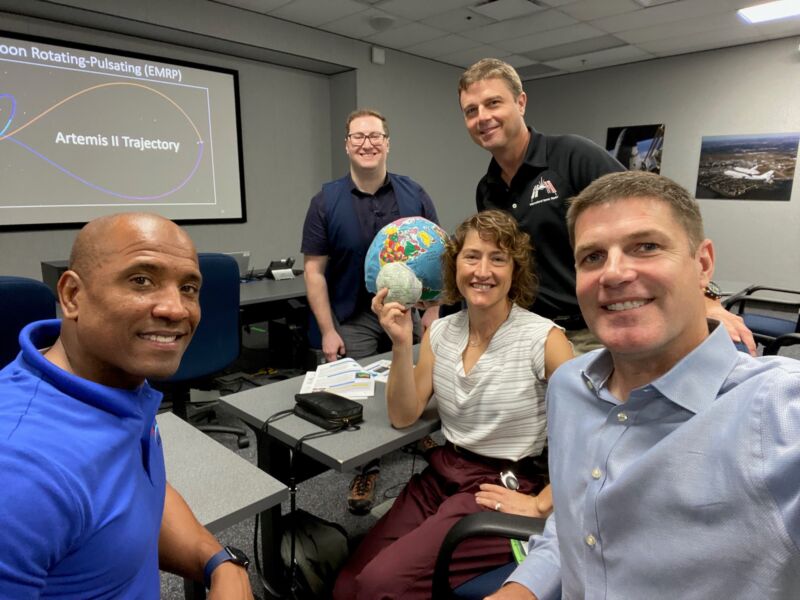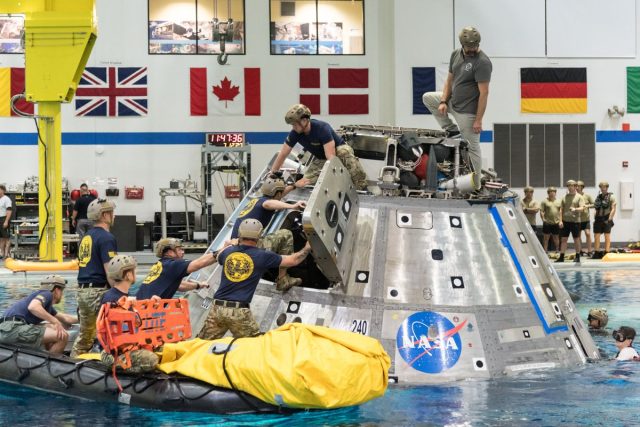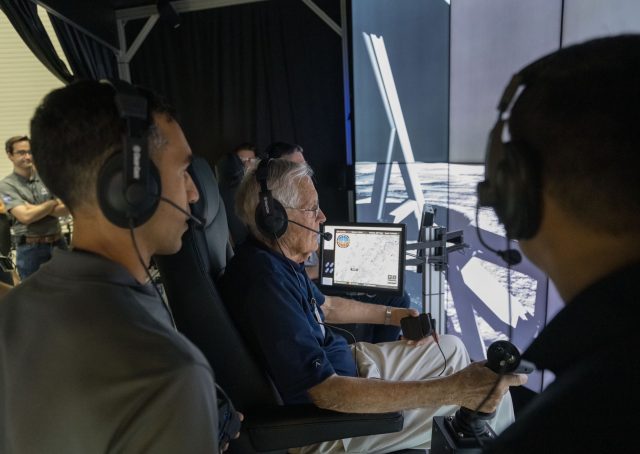“They’ve got a great adventure ahead of them.”

Astronauts Victor Glover, Christina Koch, Reid Wiseman, and Jeremy Hansen are joined by an
instructor (background) on the first day of Artemis II crew training.
NASA
The four astronauts assigned to soar beyond the far side of the Moon on NASA’s Artemis II mission settled into their seats inside a drab classroom last month at the Johnson Space Center in Houston. It was one in a series of noteworthy moments for the four-person crew since NASA revealed the names of the astronauts who will be the first people to fly around the Moon since 1972.
There was the fanfare of the crew’s unveiling to the public in April and an appearance on The Late Show with Stephen Colbert. There will, of course, be great anticipation as the astronauts close in on their launch date, currently projected for late 2024 or 2025.
But many of the crew’s days over the next 18 months will be spent in classrooms, on airplanes, or in simulators, with instructors dispensing knowledge they deem crucial for the success of the Artemis II mission. In the simulator, the training team will throw malfunctions and anomalies at the astronauts to test their ability to resolve a failure that—if it happened in space—could cut the mission short or, in a worst-case scenario, kill them.
“In order to do those things, what knowledge do we have to impart to them? What skills do we have to teach them?” said Jacki Mahaffey, NASA’s leading training officer for the Artemis II mission. “Overall, our goal is we've got a little bit in the classroom, but the more that we can get the crew in front of the displays in the vehicle mockups and really kind of immersed in that environment, the sooner, the better.
Commander Reid Wiseman and his crewmates—pilot Victor Glover, mission specialist Christina Koch, and Canadian astronaut Jeremy Hansen—were named to the Artemis II crew on April 3. Much of their time over the next two-and-a-half months was devoted to making a public relations tour, giving interviews, going to NASA centers around the country, visiting Capitol Hill, and meeting with Canadian Prime Minister Justin Trudeau.
Mahaffey said they also got a pre-training pep talk from Charlie Duke, who walked on the Moon on the Apollo 16 mission in April 1972. NASA hasn’t trained a crew to fly to the Moon since Apollo 17 at the end of 1972, the last time astronauts walked on the lunar surface.
Duke, now 87, told Ars he was excited to meet with the Artemis II crew and other members of NASA’s astronaut corps.
“It’s behind schedule, but, man, they’re pressing on,” Duke said. “They’ve got a great adventure ahead of them. So I wish them well, with their vehicles and the training and all.”
Training for the Moon
The Artemis II crew marked their first official training day on June 21. Like the start of many college courses, it began with a preview of the syllabus. Then, in the afternoon, the astronauts received a lesson on lunar orbital mechanics, according to Mahaffey.
Most of the crew’s lessons in June and July have been focused on “fundamentals” to give the astronauts a sense of the mission’s flight plan, the Orion spacecraft, and the Space Launch System rocket that will propel them into orbit. “It’s just a high-level overview of what all these things are, a general familiarization and orientation with what everything looks like, the basic ways to interact with the displays and some of the other hands-on pieces of the spacecraft,” Mahaffey said.
The Artemis II mission will last about 10 days, beginning with a launch from NASA’s Kennedy Space Center in Florida that will place their Orion capsule into a nearly day-long high-altitude orbit around Earth for critical checkouts of the ship’s life support systems and a test of the spacecraft’s ability to approach another object in space. The life support system was not part of the unpiloted Artemis I test flight with the SLS Moon rocket and Orion spacecraft last year, and future Artemis missions will rely on Orion rendezvousing with a lunar landing craft in deep space.
Then the spacecraft will fire its main engine to boost itself toward the Moon on a “hybrid free return trajectory” that uses gravity to bring the crew back to Earth, instead of requiring any additional major course correction burns. The outbound trip will take about four days, sending the astronauts on a course to fly more than 6,000 miles (10,000 kilometers) behind the far side of the Moon before returning directly to Earth for a splashdown in the Pacific Ocean. Depending on the Moon’s position in its orbit when Artemis II launches, the astronauts could set the record for the farthest humans have ever traveled from Earth.
Mahaffey said NASA wants to get the Artemis II astronauts into “operationally focused” training as soon as possible. That will begin with lessons on how to operate the Orion spacecraft, then simulations to have the crew members practice the tasks they will need to accomplish inside the capsule when it’s in space.
Those tasks range from executing mission-critical engine burns to preparing food and using the bathroom. Once the crew has a good understanding of the spacecraft’s design and capabilities, attention will turn to emergency training.
“We kind of step from what do we expect to happen, what can the vehicle do itself if we run into some issue with those systems, and then how would the crew help in some of those cases in contingencies?” Mahaffey said. “So we'll kind of step through those things for the on-orbit period, and phase eventually into entry and splashdown operations, as well as launch and ascent operations as well.”
It won’t just be the astronauts who get tested during training. The mission control team in Houston will also be looped into the simulations with the Artemis II crew.
“About as soon as they both kind of have their feet wet and feet under them, we want to bring them together to do it together because really, ultimately, it's one team,” Mahaffey said. “So the sooner that we are working together and figuring out those operational concepts, how the communication is working, and who's taking on what roles, the better, really, and the more prepared that the team will be to work together during the mission.”
Most of the Artemis II training will occur at the astronauts’ home base in Houston. Aside from their classroom and simulator work, the crew members will go to the Neutral Buoyancy Laboratory, a giant pool near the Johnson Space Center that is more commonly used for spacewalk training. There are no spacewalks planned on Artemis II, but the astronauts are using the pool to practice how they will get out of the Orion spacecraft at sea.

Artemis II astronauts and recovery teams rehearsed procedures last week with a mock-up of an
Orion spacecraft at the Neutral Buoyancy Laboratory in Houston.
NASA
One of the first training trips outside Houston for the Artemis II crew will likely be to San Diego, where the astronauts will meet the US Navy recovery team that will greet them in the Pacific at the end of the mission.
A regular training destination for the Artemis II astronauts will be the Kennedy Space Center, where they will work with the Artemis launch team and the closeout crew that will help them strap into their seats before liftoff. They will also train with US military pararescue forces that will be on call to find and rescue the crew in the event of a launch abort or an off-target splashdown.
As the exact flight plan becomes clearer, Mahaffey said NASA will brief the astronauts on what scientific observations they can make of the far side of the Moon. “Once we get closer to the mission and have a little bit more idea of exactly what the flyby will look like, we’ll talk specifically about what should we do during this short period of time where we have a chance to look at the far side of the Moon.”
Moonwalker visited Artemis crew
The Artemis III mission will follow Artemis II with the new Moon program’s first attempt to land people on the lunar surface. Like Artemis II, the four astronauts on Artemis III will take off on an SLS rocket and Orion spacecraft, then connect with a commercial human-rated landing vehicle derived from SpaceX’s Starship rocket. Starship will then take two of the astronauts to a landing site near the Moon’s South Pole for a series of moonwalks before launching back into space to rendezvous with Orion for the journey back to Earth.
Artemis III will be the first of what NASA hopes will eventually be yearly crew flights to the Moon. But when, or if, NASA can ever meet that goal remains unclear. NASA's inspector general says one flight of the fully expendable SLS rocket and Orion spacecraft, including ground system expenses, will cost $4.2 billion per mission through Artemis IV, which is projected to launch in 2028.
Continuing to fund the Artemis launch vehicle and crew capsule could strain NASA’s budget for other elements of the lunar program. And while NASA’s SLS rocket and Orion spacecraft performed well on the Artemis I test flight last year—after more than a decade in development—the agency’s lunar lander providers SpaceX and Blue Origin are in an earlier phase of design and testing, as are the new spacesuits to be worn by astronauts walking on the Moon.
“They’ve got a very difficult mission,” Duke said. “The landing area they’re going into seems to be very rough, and a lot of deep shadows. If you look at the vehicle that they’re going to fly in, it’s got a lot more technology than we had, but it’s a lot bigger, too.”

Apollo 16 moonwalker Charlie Duke operates a simulator during a recent visit with NASA astronauts.
NASA
Duke said he had a good discussion with the current crop of NASA astronauts preparing to fly on Artemis missions. Duke is one of 10 men still alive of the 24 astronauts who flew to the Moon in the Apollo program. He's one of the four moonwalkers still living.
“They were very interested in how we did things in Apollo,” Duke said. “But a lot of Apollo doesn’t apply to them, though, because the technologies are so different.”
However, the Artemis astronauts, beginning with Artemis II, will see Earth in a similar way the Apollo crews did more than 50 years ago. On the Apollo 8 mission, Jim Lovell described the “vast loneliness” of the Moon and compared Earth to a “grand oasis in the big vastness of space.”
But the perspectives of the Artemis II astronauts could be different. All were born after the final Apollo landing, and the Artemis II crew will include the first woman, the first person of color, and the first international astronaut to fly on a lunar mission.
Duke said his focus on Apollo 16 was on completing the mission, except for one moment.
“As we came around from the back side of the Moon and looked out at the Earth, the thought hit you, ‘Man, we’re a long way from home. I hope this thing holds together,’” he said. “But you don’t dwell on it. That’s a beautiful Earth out there, but your focus is more on your objectives on the flight.”
Duke hopes to travel to Florida for the Artemis II launch. “It ought to be thunderous,” he said.
Source




3175x175(CURRENT).thumb.jpg.b05acc060982b36f5891ba728e6d953c.jpg)



Recommended Comments
There are no comments to display.
Join the conversation
You can post now and register later. If you have an account, sign in now to post with your account.
Note: Your post will require moderator approval before it will be visible.